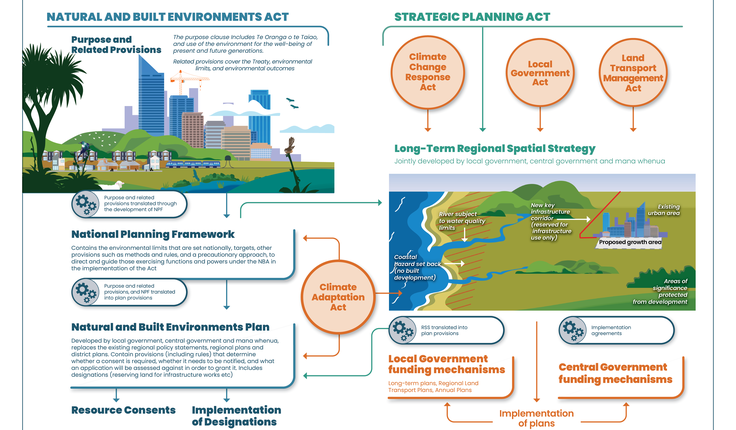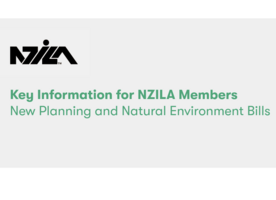News
Reforming the RMA - why landscape architects should care
Posted 06 07 2021
in News

The NZILA is welcoming the much anticipated governmental release of the draft of the laws which will replace the Resource Management Act (RMA) - but does have some concerns.
The release is another step in the long process to replace the heavily criticised RMA which the government has accused of not only holding up urban development but also of not doing its job to protect the natural environment.
NZILA Advocacy Panel Member Rachel de Lambert says the Natural Built Environments Bill (NBEB) is hugely important to the practice of many landscape architects across Aotearoa and she does have some concerns.
“Whilst the draft provisions continue to provide for the ‘protection, restoration or improvement’ of outstanding natural features and landscapes, (which we welcome) protection for the ‘every-day’ landscapes in the rural or urban context appears to have been reduced.
“The Bill has a focus on biophysical outcomes which are important and do need to be improved, but ‘the quality of the environment’ which would address landscapes in a wider context, has not been included in Section 8, ‘Environmental Outcomes’. This is of concern to us as is the move away from the consideration of amenity values and the character of the landscapes we all live in day to day.
“At the same time we welcome the requirement ‘to give effect to’ the principles of te Tiriti o Waitangi and the upholding of te Oranga o te Taiao (the health of the natural environment).”
She says it is vital the NZILA makes a submission on these draft laws and the Institute’s RMA Working Group will be meeting next week.
“It’s early days but we will be looking to find constructive ways to propose changes and additions recognising the matters the Government is seeking to address through the new legislation but also seeking to avoid poor future outcomes in terms of the landscape of Aotearoa and how it can be improved for future generations.”
Rachel says this reform is very significant.
“This Bill, as part of the new suite of legislation including the ‘Strategic Planning Act (SPA) and the Climate Change Adaptation Act (CCAA) provides the fundamental legislative framework for planning and the consideration of landscape values in Aotearoa, as such they are of primary importance to landscape architects.”
The Ministry for the Environment says the three proposed new pieces of legislation to replace the RMA are:
Natural and Built Environments Act
The proposed Natural and Built Environments Act (NBA) is intended to be the primary piece of legislation to replace the RMA. Like the RMA, the National and Built Environments Act will be an integrated statute for land use and environmental protection. It will work in tandem with the proposed Strategic Planning Act (SPA).
The Act sets out how the environment will protect and enhance the future system, ensuring people and communities use the environment in a way that not only supports their well-being but that of future generations.
This would be achieved by:
- Promoting positive outcomes for both the natural and built environments.
- Ensuring that use, development and protection of resources only occur within prescribed environmental limits.
- The NBA will also improve recognition of te ao Māori and Te Tiriti o Waitangi. This includes reference to Te Oranga o te Taiao in the Act’s purpose. This concept is intended to encapsulate the intergenerational importance of the health and well-being of the natural environment. Decision-makers would be required ‘to give effect to’ the principles of Te Tiriti, replacing the current RMA requirement to ‘take into account’ those principles.
- Under the Act, central government’s proposed new National Planning Framework will provide a set of mandatory national policies and standards on specified aspects of the new system. These will include natural environmental limits, outcomes and targets.
Strategic Planning Act
The Strategic Planning Act provides a strategic and long-term approach to how we plan for using land and the coastal marine area.
Long-term spatial strategies in each region will be developed to identify areas which:
- Will be suitable for development.
- Need to be protected or improved.
- Will need new infrastructure and other social needs such as hospitals and schools
- Are vulnerable to climate change effects and natural hazards such as earthquakes.
The regional strategies will enable more efficient land and development markets to improve housing supply, affordability and choice, and climate change mitigation and adaptation.
The Government has established a new interdepartmental executive board, the Strategic Planning Reform Board, to oversee the development of the Act. This is as part of the wider resource management reforms.
It will be only the second interdepartmental Executive Board established under the Public Service Act 2020.
Read more about the Strategic planning board here.
Climate Adaptation Act
This Act will support New Zealand’s response to the effects of climate change. It will address the complex legal and technical issues associated with managed retreat and funding and financing adaptation.
Together this suite of legislation will:
- Protect and restore the environment and its capacity to provide for the wellbeing of present and future generations.
- Better enable development within natural environmental limits.
- Give proper recognition to the principles of Te Tiriti of Waitangi and provide greater recognition of te ao Māori including mātauranga Māori.
- Better prepare for adapting to climate change and risks from natural hazards, and better mitigate emissions contributing to climate change.
- Improve system efficiency and effectiveness, and reduce complexity while retaining appropriate local democratic input.
Basis for Refrom
The reform is based on the findings of the comprehensive review of the resource management system which were released last year. The review was carried out by the independent Resource Management Review Panel led by Hon Tony Randerson, QC. It is the most significant, broad-ranging and inclusive review of the resource management system since the Resource Management Act 1991 (RMA) was enacted.
See the Minister for the Environment David Parker speak about the reform in the video below.
10 Dec
Proposed replacement of the RMA: Planning Bill and Natural Environment Bill

A message from the Environmental Legislation Working Group
On Tuesday this week, the Government released proposed bills to replace the Resource Management Act 1991. Reform of our planning …
03 Dec
Newly Registered Landscape Architects 2025

Celebrating professional achievement across Aotearoa The 2025 Registration process is now nearing completion, and we are delighted to acknowledge the …
02 Dec
2025 IFLA APR Newsletter

November Edition
2025 IFLA APR Newsletter: November Edition November brings exciting updates from across the region. We’re welcoming the new IFLA APR …
Events calendar
Full 2025 calendar